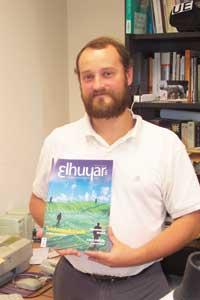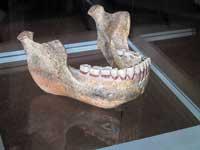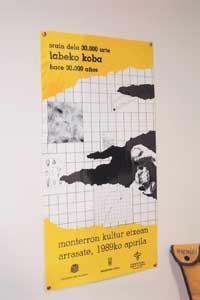Alvaro Arrizabalaga: "our problem is data scarcity"

Homo Heilderbergensis Neanderthal is considered the direct ancestor of man by the traces found in Europe. So are they species created in Europe?
It is not entirely clear. This is a proposal found in the scientific world, since its geographical distribution is quite similar. In any case, we should say that they are not of European origin but of Eurasian origin.
But according to the fossils of Iraq and Israel, it seems that they emerged in Europe and then went to the east. Isn't that a good reading?
This is also not entirely clear because there we find dating problems, with the limit of carbon 14. Most Neanderthals are considered to be over 30,000 years old and with this limitation a distribution or dispersion map can hardly be made. That is, we cannot draw arrows to determine where they were created and where they went. For this, it is necessary to make thermoluminescence dating, which are much more difficult, since this method of dating is not universal.
The base must be a silicate heated to a very high temperature, so it must take a burnt flame and not of any kind, it must be burned in specific and larger conditions in order to remove the debris of contamination in the outer layers. It is a fairly complex process. In Euskal Herria has not yet been done.
However, at one time no importance was given to this shellfish discovered in Mauer (Heilderberg), but it is finally becoming a very important fossil.

Cro-Magnon, on the other hand, seems to have been born in Africa, but we have few clues. What can be the reason?
There we have a problem, because African archaeology is not very developed. For example, in the case of the australopite and excavations for the study of the first human beings yes, but this is due to colonial archaeology. Researchers who have traveled to Kenya, Tanzania and Ethiopia are from the United States and Europe. But the human excavation of Cro-Magnon is not so developed.
Fossil shortages may be due to this. If no explorations are made to find caves, fossils will hardly be obtained. We know the Middle East well. And the key is in the Middle East, where we see the modern man of 100,000 years ago, together with a man of archaic appearance.
And then, when the Europeans entered the north (Syria, Iraq and Kurdistan) a situation arose that has not emerged anywhere else; the traces that reflect it are 60,000 years ago. In the same territory there were two very different human species. It is not yet very clear what the situation was, but there was no automatic substitution, the two species remained in the same place.
And we would see that this situation is similar to that of North Africa if we analyzed it better. But there we find sociological and political limits to address archaeology. In the case of Morocco, for example, the archaeology of certain epochs is prohibited, since in the Arabization the chronometer of the people was emptied, and the study of the previous identity is not, to some extent, politically appropriate.
As for your work, it is curious the case of the cave of Labeko. There were remnants of the transition from the man of Neanderthal to the man of Cro Magnon. But since they had to build a road in Arrasate-Mondragón, the cave was destroyed; however, due to your request, they gave them facilities to remove their remains in a very short time. Is it not a paradoxical situation?

Its explanation is quite complex. This type of situation occurs daily in Euskal Herria, as more and more public works are being carried out. Within a week you must decide whether you will start excavating the site. You may know beforehand whether it is interesting or not, but until you start digging you cannot assess what will be inside.
In the case of the furnace cave, it is true that the cave was destroyed, but it is true that the deposit was not destroyed. The site is the one that was inside the cave and in its day there was an opportunity for all this to go well.
What did they have to give up from the point of view of the investigation?
Well, you have had to make adaptations in the methodology. We are used to sampling the entire profile, but in this case the emptying was quick. For example, palinology sampling is done in four columns. That is adaptation. In the absence of time, the critical factor is that the material comes out as you think. But in interpretation this adaptation can be 10%. You have your capacity reduced by 10%. Every day we see that other important deposits never leave because grants or administrative authorizations are not granted, etc. With this I mean that I have a bittersweet taste.
However, when previous efforts are made, the mechanisms that we have interspersed often work. For example, in the case of the high-speed train, Lezetxiki was going to be reduced, but it has been prevented. After making the allegations in time we managed to move the train route. They have moved 200 meters and for us those 200 meters are very important.
According to the fossils, the Cro-Magnon did not follow the south of the Ebro after the occupation of the territory. Why this rarity?
There are also several hypotheses and not everyone agrees. Our problem is data scarcity. But according to the information we have, the last European Neanderthals were at the lower end of the peninsula.
Did they go south to meet the sea?

I do not think that for Neanderthal Gibraltar would be an obstacle to continue towards Africa. The Australian colonization is very old, for example, and for this it is necessary to know the navigation, that is, to do it by boat.
Isn't it possible for Australians to know navigation and Europeans not?
Possible, yes. But this intelligence had no biological limits to make such preestablished inventions. At the time it was stated that colonization and the American population must necessarily be from the time of a glaciation to be able to circulate on the ice, since these human beings could not sail at all or know how a boat is built. And now we know that 50,000 years ago Australia was populated.
So can Neanderthal remains appear in North Africa?
Yes. In fact, there are tools like Moustier. Finding fossils is another thing. Complex. However, it seems that the last Neanderthals we know in Europe lived in the Iberian Peninsula, dating from 28,000-27,000 years and that, normally, have been found alongside Moustier's instruments. However, we do not know where the man of Cro-Magnon was born. The oldest dates in western Europe are also found in the Iberian Peninsula. In his day he proposed the creation of the Upper Palaeolithic instrument of modern man in the north of the peninsula, but it is not very clear.
Buletina
Bidali zure helbide elektronikoa eta jaso asteroko buletina zure sarrera-ontzian











